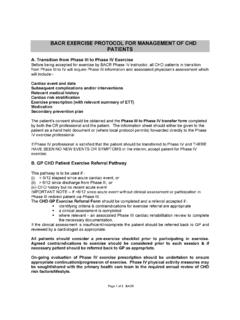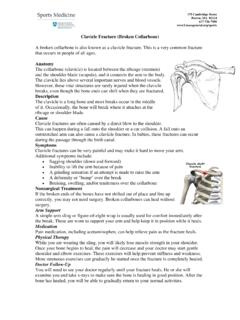Transcription of The BACPR Standards and Core Components for …
1 The BACPR Standards and Core Components for Cardiovascular Disease Prevention and rehabilitation 2017. (3rd Edition). RM S T R AT. -TE EG. IE. NG S. LO. Ps or n t e r i s k st yl yc al th e m a n a g ac t ho he em Li fe f soc Health i al behaviour change and education Me dical risk man agement AU. DI O N. T A TI. N D E VA L U A The Six Core Components for Cardiovascular Disease Supported by Prevention and rehabilitation The British Association for Cardiovascular Prevention and rehabilitation is an affiliated group of the Supported by Foreword All health care professionals are motivated to provide the best care and achieve the optimal outcomes for their patients. This has been a recurrent ambition I have heard from colleagues working in the front line of the NHS. The 3rd edition of the BACPR Standards & Core Components provide an excellent and essential guide to support cardiac rehabilitation and prevention programmes across the UK.
2 Taking the findings of research and translating these into day to day practice is the starting point of a chain of events that will achieve this ambition. The evidence-based Standards allow us to drive quality improvement and the National Audit of Cardiac rehabilitation allows us to know how well we are doing. None of this however would be possible without the efforts of the healthcare professionals providing cardiac rehabilitation across the UK. Cardiovascular disease is a long term condition. Saving someone's life following a heart condition is vital, but giving them a fulfilling life that is worth living is equally important. The aims of cardiac rehabilitation and prevention is to provide the patient and family with the skills and knowledge to self-manage, facilitate recovery both physically and psychologically and educate to reduce the risk of further CVD events, as well as achieving an absolute risk reduction in cardiovascular mortality.
3 The NHS should provide and fund evidence-based care, but the reduction in hospital admissions for patients who receive comprehensive cardiac rehabilitation , there exists an added financial motive to invest in these essential services. Leo was 47 when he had a heart attack followed by triple bypass surgery. While he was in hospital he was offered a place on a cardiac rehabilitation programme . Following cardiac rehabilitation , as he says, it is about being in control I definitely feel much better in myself. I'm more in control of my own health than I ever was before.. The BHF is delighted to be able to support the publication of these updated Standards and Core Components , but more importantly work with the BACPR team and members, to promote excellence in cardiovascular disease prevention and rehabilitation .
4 Dr Mike Knapton, Associate Medical Director, BHF. Contents 1 Introduction 1. Definition 1. Evidence 2. National and local factors for assuring quality 3. Cardiac rehabilitation pathway of care 3. Funding 4. 2 The Standards 5. The delivery of six core Components by a qualified and 6. competent multidisciplinary team, led by a clinical coordinator Prompt identification, referral and recruitment of eligible 7. patient populations Early initial assessment of individual patient needs, which 8. informs agreed personalised goals that are reviewed regularly Early provision of a structured cardiovascular prevention 9. and rehabilitation programme (CPRP), with a defined pathway of care, which meets the individual's goals and is aligned with patient preference and choice Upon programme completion, a final assessment of 10.
5 Individual patient needs and demonstration of sustainable health outcomes Registration and submission of data to the National Audit 10. for Cardiac rehabilitation (NACR) and participation in the National Certification programme is desirable 3 The Core Components 11. Health behaviour change and education 12. Health behaviour change 12. Education 12. Lifestyle risk factor management 13. Physical activity and exercise 13. Healthy eating and body composition 14. Tobacco cessation and relapse prevention 14. Psychosocial health 15. Medical risk management 16. Long-term strategies 17. Audit and evaluation 18. 4 Appendices 20. Appendix 1 References 20. Appendix 2 Acknowledgements 24. 1. Introduction This is an update (third edition) of the BACPR Standards & Core Components and represents current evidence-based best practice and a pragmatic overview of the structure and function of Cardiovascular Prevention and rehabilitation Programmes (CPRPs) in the UK.
6 The previously described seven Standards have now been reduced to six but without sacrificing any of the key elements and with a greater emphasis placed on measurable clinical outcomes, audit and certification. Similarly, the second edition provided an overview of seven core Components felt to be essential for the delivery of quality prevention and rehabilitation , and this too has been reduced to six. The interplay between cardio-protective therapies and medical risk factors is almost impossible to disentangle for the vast majority of patients and even if specific drug therapies are deployed exclusively for risk factor modulation, the indirect effect will also be cardio-protective. Thus, these have been combined into a single core component medical risk management. This updated and revised third edition is designed to build upon the success of the earlier publications and to refocus the attention of commissioners, health-care professionals, politicians and the public on the critical importance of robust, quality markers of service structure and content.
7 However, the overarching aim of these Standards and core Components remains unchanged to provide a blueprint upon which all effective prevention and rehabilitation services are designed and a template through which any variation in quality of service delivery can be assessed. It is recognised that cardiac rehabilitation (CR) has an established evidence-base and existing services are in a strong position to evolve in order to provide care to include an ever-broadening spectrum of in-scope patients, from those with established atherothrombotic vascular disease right through to those asymptomatic individuals who have been deemed at high risk for the future development of adverse cardiovascular In addition, there is enormous overlap in terms of profile and potential benefits for patients with other non-communicable diseases, particularly individuals with chronic respiratory disease and certain forms of Therefore, an opportunity exists to further expand the influence of prevention and rehabilitation services which may, in turn.
8 Allow financial resources to be released and a more cost-effective deployment of staff and facilities to take place. All such potential developments will require innovative practice and close working between providers and commissioners whilst also adhering to the principles set out within this BACPR Standards & Core Components document. Definition There are many definitions of cardiac The following definition presents their combined key elements: The coordinated sum of activities* required to influence favourably the underlying cause of cardiovascular disease, as well as to provide the best possible physical, mental and social conditions, so that the patients may, by their own efforts, preserve or resume optimal functioning in their community and through improved health behaviour, slow or reverse progression of disease.
9 *The BACPR 's six core Components for cardiovascular disease prevention and rehabilitation constitute the coordinated sum of activities. Standards and Core Components 2017 (3rd Edition) 1. 1. Introduction In meeting these defined goals, all CPRPs should aim to offer a service that takes a multidisciplinary biopsychosocial approach in order to best influence uptake, adherence and long-term healthier living. The involvement of partners, other family members and carers is also Evidence The evidence base that supports the merits of comprehensive CR is robust and consistently demonstrates a favourable impact on cardiovascular mortality and hospital re-admissions in patients with coronary heart disease12 although there remains some uncertainty regarding the effect of CR on all-cause For patients who have experienced myocardial infarction (MI) and/or coronary revascularisation, attending and completing a course of exercise-based CR is associated with an absolute risk reduction in cardiovascular mortality from to when compared to those who do not receive CR, with a number needed to treat (NNT) of 37.
10 In terms of recurrent MI and repeat revascularisation, the effect of CR would appear to be neutral, however, there is a significant reduction in acute hospital admissions (reduced from to , NNT 22) which is a key determinant of the intervention's overall For individuals with a diagnosis of heart failure, CR may not reduce total mortality but does impact favourably on hospitalisation, with a 25% relative risk reduction in overall hospital admissions and a 39% reduction (NNT 18) in acute heart failure related The consequences of relapse and readmission are enormous in terms of quality of life, associated morbidity and financial impact thus the more recent emphasis on the importance of CR for heart failure patients within national and international guidelines. In terms of direct measures of anxiety, depression and quality of life, CR.







